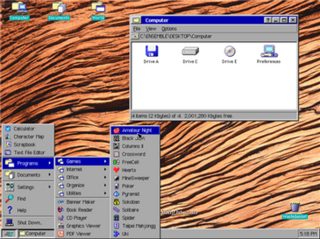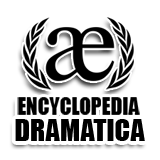Related Research Articles

AOL is an American web portal and online service provider based in New York City. It is a brand marketed by the current incarnation of Yahoo! Inc.
In the Internet, a domain name is a string that identifies a realm of administrative autonomy, authority or control. Domain names are often used to identify services provided through the Internet, such as websites, email services and more. As of 2017, 330.6 million domain names had been registered. Domain names are used in various networking contexts and for application-specific naming and addressing purposes. In general, a domain name identifies a network domain or an Internet Protocol (IP) resource, such as a personal computer used to access the Internet, or a server computer.

CompuServe was an American online service, the first major commercial one in the world – described in 1994 as "the oldest of the Big Three information services ."
An online service provider (OSP) can, for example, be an Internet service provider, an email provider, a news provider (press), an entertainment provider, a search engine, an e-commerce site, an online banking site, a health site, an official government site, social media, a wiki, or a Usenet newsgroup.
MP3.com is a web site operated by CNET Networks publishing tabloid-style news items about digital music and artists, songs, services, and technologies. It is better known for its original incarnation as a legal, free music-sharing service, named after the popular music file format MP3, popular with independent musicians for promoting their work. That service was shut down on December 2, 2003, by CNET, which, after purchasing the domain name, established the current MP3.com site.
Yahoo! GeoCities was a web hosting service that allowed users to create and publish websites for free and to browse user-created websites by their theme or interest. GeoCities was started in November 1994 by David Bohnett and John Rezner, and was named Beverly Hills Internet briefly before being renamed GeoCities. On January 28, 1999, it was acquired by Yahoo!, at which time it was reportedly the third-most visited website on the World Wide Web.
Webs, formerly Freewebs, is a freemium, primarily static site-only web host founded in 2001. The service offers free and premium website hosting plans, and their own templated website building service. Unusually, Webs does not offer any dynamic content support aside from their own dynamic "apps", despite offering FTP access and allowing HTML uploads.
Trespass to chattels is a tort whereby the infringing party has intentionally interfered with another person's lawful possession of a chattel. The interference can be any physical contact with the chattel in a quantifiable way, or any dispossession of the chattel. As opposed to the greater wrong of conversion, trespass to chattels is argued to be actionable per se.
AOLpress is a discontinued HTML editor that was available from America Online (AOL). It was originally developed as NaviPress by the company NaviSoft before being bought by AOL. It was discontinued in 2000. However, the last version (2.0) may still be found on some Web sites for downloading.

GEOS is a computer operating environment, graphical user interface (GUI), and suite of application software. Originally released as PC/GEOS, it runs on DOS-based, IBM PC compatible computers. Versions for some handheld platforms were also released and licensed to some companies.

Tripod.com is a web hosting service owned by Lycos. Originally aiming its services to college students and young adults, it was one of several sites trying to build online communities during the 1990s. As such, Tripod formed part of the first wave of user-generated content. Free webpages are no longer available and have been replaced by paid services.

Personal web pages are World Wide Web pages created by an individual to contain content of a personal nature rather than content pertaining to a company, organization or institution. Personal web pages are primarily used for informative or entertainment purposes but can also be used for personal career marketing, social networking with other people with shared interests, or as a space for personal expression.
WHOIS is a query and response protocol that is widely used for querying databases that store the registered users or assignees of an Internet resource, such as a domain name, an IP address block or an autonomous system, but is also used for a wider range of other information. The protocol stores and delivers database content in a human-readable format. The current iteration of the WHOIS protocol was drafted by the Internet Society, and is documented in RFC 3912.
Naver is a South Korean online platform operated by the Naver Corporation. It was launched in 1999 as the first web portal in South Korea to develop and use its own search engine. It was also the world's first operator to introduce the comprehensive search feature, which compiles search results from various categories and presents them in a single page. Naver has since added a multitude of new services ranging from basic features such as e-mail and news to the world's first online Q&A platform Knowledge iN.
AOL Radio powered by Slacker was an online radio service available in the United States only. It had over 200 free internet radio stations.

Internet censorship is the legal control or suppression of what can be accessed, published, or viewed on the Internet. Censorship is most often applied to specific internet domains but exceptionally may extend to all Internet resources located outside the jurisdiction of the censoring state. Internet censorship may also put restrictions on what information can be made internet accessible. Organizations providing internet access – such as schools and libraries – may choose to preclude access to material that they consider undesirable, offensive, age-inappropriate or even illegal, and regard this as ethical behaviour rather than censorship. Individuals and organizations may engage in self-censorship of material they publish, for moral, religious, or business reasons, to conform to societal norms, political views, due to intimidation, or out of fear of legal or other consequences.
Scour Inc. was a multimedia Internet search engine, and provided Scour Exchange, an early peer-to-peer file exchange service.
The Internet in Kazakhstan is growing rapidly. Between 2001 and 2005, the number of Internet users increased from 200,000 to 1 million. By 2007, Kazakhstan reported Internet penetration levels of 8.5 percent, rising to 12.4 percent in 2008 and 34.3% in 2010. By 2013, Kazakhstani officials reported Internet penetration levels of 62.2 percent, with about 10 million users. There are five first-tier ISPs with international Internet connections and approximately 100 second-tier ISPs that are purchasing Internet traffic from the first-tier ISPs. As of 2019, more than 75% of Kazakhstan's population have access to the internet, a figure well ahead of any other country in Central Asia.

Encyclopedia Dramatica is a satirical online community centered around a wiki that acts as a "troll archive". The site hosts racist material and shock content; as a result it was filtered from Google Search in 2010. It has been linked to the 2017 Aztec High School shooting and participates in harassment campaigns.

Archive Team is a group dedicated to digital preservation and web archiving that was co-founded by Jason Scott in 2009.
References
- 1 2 Posted on Sep 30th 2008 10:06AM by Kelly Wilson. "We're Closing Our Doors - People Connection Blog: AIM Community Network". Archived from the original on 2008-11-02. Retrieved 2020-05-20.
- ↑ Hogan, Lynn (1995). Creating a Web Page Using AOL Hometown, Appendix C to the online book Practical Computing, published on Pearson Education
- ↑ Internet Baby Steps - Lesson 19: Creating a Simple AOL Home Page Archived 2012-03-31 at the Wayback Machine , Alexander Magazine, 2001
- ↑ Willett, Edward (2000). Your Official America Online Guide to Creating Cool Web Pages, 2nd Edition
- ↑ Schau, Hope Jensen; Gilly, Mary C. (2003). We are what we post? Self-presentation in personal web space, Journal of Consumer Research, December 1, 2003
- ↑ Musgrove, Mike (2001). Free, easy site-hosting services tap into the urge to post Archived 2011-10-04 at the Wayback Machine , The Washington Post, January 28, 2001
- ↑ Hu, Jim (2002). AOL home page glitches irk users, CNET News, February 1, 2002
- 1 2 3 Scott, Jason (2008). Eviction, or the Coming Datapocalypse, December 21st, 2008
- ↑ Scott, Jason (2009). Datapocalypso!, January 5th, 2009
- ↑ Scott, Jason (2009). STAND BACK, WE’RE ARCHIVISTS, January 9th, 2009
- ↑ Internet Archive (2009).GeoCities Special Collection 2009: Saving a Historical Record of GeoCities
- ↑ "A Web Site is Not So Terribly Hard to Weave". Los Angeles Times . 31 March 1997.
- ↑ "PC Mag - Google Books". 9 September 1997. Retrieved 2020-05-20.
- ↑ "Internet Q&A". Archive.nytimes.com. 1996-06-07. Retrieved 2020-05-20.
- ↑ "Chapter 19 - Getting Your Web Words Online with America Online". Gbengasesan.com. Retrieved 2020-05-20.
- ↑ Einstein, David (1998-01-20). "Web Site Creation Is Free, Easy". SFGate. Retrieved 2020-05-20.
- ↑ "Unhappy AOL Campers - The New York Times". The New York Times . 2000-04-13. Retrieved 2020-05-20.
- ↑ https://www.americanradiohistory.com/UK/Mapelin/Maplin-Electronics-1996-08.pdf [ bare URL PDF ]
- ↑ "PC Mag". 23 April 1996.
- ↑ "PC Mag - Google Books". 1999-04-06. Retrieved 2020-05-20.
- ↑ http://whois.pho.to/hometown.aol.co.uk . Retrieved August 21, 2011.
{{cite web}}: Missing or empty|title=(help)[ dead link ] - ↑ Google Scholar search result for "AOL Hometown"
- 1 2 3 Nii, Jenifer K. (1999). Family history Web site joins AOL, Deseret News, September 30, 1999
- ↑ StatCounter provides free customisable hit counters, visitor tracking and website stats for AOL Hometown Archived June 24, 2011, at the Wayback Machine
- ↑ Huggins, James S. (1997?). Using AOL Hometown easyDesigner
- ↑ "AOL-CompuServe deal cleared". CNET. 1997-11-10. Retrieved 2008-04-15.[ permanent dead link ]
- ↑ AOL Japan to transfer Net business to eAccess, The Japan Times, May 18, 2004,
- ↑ Matsuoka, Ken (2008). AOL Announcement: "AOL Hometown/FTP is closing 31st October 2008", 5 December 2008
- ↑ AcmeCity and AOL Hometown Collaboration, 2001
- ↑ "Immerhin hat AOL im Gegensatz zu manchen anderen Providern oder Gratisangeboten immerhin eine 'Haltbarkeit' von über 17 Jahren gehabt." ("Different from what other providers or free services would have given me, AOL gave my site a 'durability' of more than 17 years.") Chactory, thread Google warnt vor der gesamten AOL-Domain [ permanent dead link ] ("Google advises against all AOL domains"), 2 October 2008